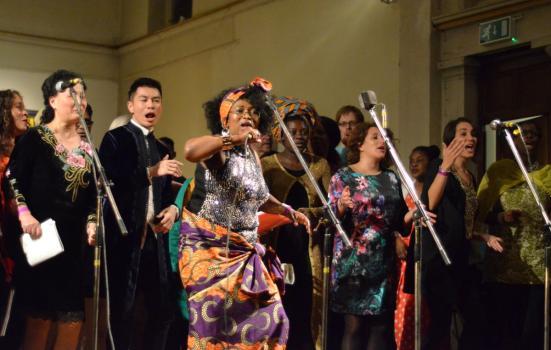Applying for project funding from Arts Council England is time-consuming, fraught and very often unsuccessful, as Tony Haynes knows only too well.

Imagine you are an independent company or creative artist teeming with new ideas. These ideas are clearly inclusive and relevant, express diversity creatively, engage young people and depend on the participation of local communities.
They may also be time-dependent – related perhaps to an historic anniversary, or addressing a contemporary social issue or hot topic important to the communities you serve. You naturally think: surely here we have the makings of a strong Arts Council England project grant application?
You spend the next month or so bringing all your ideas together. They have of course been brewing for a while, so it’s mostly a question of consolidating them into a coherent project. You confirm the artists, whose lived experience is essential to the overall content; you consult with your local networks and partners; you line up accessible venues for workshops and performances; you raise match funding and help in kind; you check media interest and sketch out a PR/marketing campaign. Then you open the online form…
Helplessness and anxiety
To begin with, after just 50 words to summarise your project, you may be alarmed that you have only 800 characters (less than the length of the first two paragraphs of this article) to describe your project in full. However, you then realise that a lot more solid information can be spread amongst the 18,000 or so characters allowed in later sections responding to ACE Let’s Create and Investment Principles questions. You see you are also allowed a 5-page attachment, which you pack with photos, audio/video links, reviews and vox pop feedback to attest to your track-record.
You carefully budget your project, which comes out to say £28,000 towards £80,000-worth of work (mostly led by experienced freelancers). You submit and wait…
Meanwhile, you continue to develop your project (but without any financial support), keeping all the elements on the boil. By the time you hear the outcome of your bid, you will have to get going very quickly. Inevitably you spend two months in a state of some helplessness and anxiety. Then you get a short email like this: “We decided that your application was less strong than others we received.”
This is followed by an attempt at more helpful feedback: “While acknowledging the benefits of the proposed activities and likely impact in the target communities, the application would have been strengthened by further specific details of the activities planned in demonstrating delivery of Let's Create Outcomes and alignment with the Investment Principles. Including examples of target participants/audiences and how they would be recruited/reached would also have strengthened it.”
Reality kicks in
It could take a while to absorb the blow. Surely, you think, you gave full and detailed answers to all these questions. Have those making the decisions ever experienced your work first-hand? But then reality kicks in.
How are you now going to deliver a project that has already raised expectations among those who have valued, supported and depended on your work for years? Are you to give back match funding, or turn down offers of in-kind support? Waiting or re-submitting isn’t an option if the project is time dependent.
Of course, the only thing you can do is go ahead as best you can. You dip into reserves, cut expenditure wherever possible, rely on artists’ loyalty and the goodwill of venues and promoters, beg and borrow favours and hope for better luck next time.
Grim reality for creative artists
This story of course will be familiar to many readers. But those on the outside, or venturing into the arts world for the first time, may not know what obstacles and perils lie ahead, how capricious the system can be, and how harsh its human impact.
It’s certainly been a grim reality for creative artists like me and independent artist-led companies like the Grand Union Orchestra for a dozen years now. However, thanks to the resilience that comes with experience, we’ve learned to live with it.
It doesn’t help to know that each panel has only about £170,000 to distribute, considers perhaps 20 applications and funds about 7 of them; nor that the feedback is selected from dropdown menus.
But is this the best way to make use of the vivid imaginations, sweeping vision and irrepressible energy of artists in a society which is in desperate need of social, moral and cultural rebuilding and renewal?
We risk squandering artistic impetus
I fully sympathise with Darren Henley and his colleagues at the Arts Council who have to make such carefully balanced decisions between supporting, say, cultural institutions and individual artists and companies (or, as you might put it, between favouring NPOs and independent arts organisations) and face down entrenched interests. But their relationship is symbiotic, their fortunes deeply interlinked: each needs the other, and we risk squandering artistic impetus and creative momentum unless we address this.
I reflected on this dilemma in a series of blog posts during the Covid-haunted years, when so many hidden fault lines in our cultural landscape were exposed as the permafrost thawed. In the last of these, I suggested we seemed to have lost track of what art and artists are for in our society today.
It borrowed the title of the Arts Council’s 10-year strategy ‘Let’s Create’, which boldly declares: “The cultural sector will only ever be as strong as the talent on which it is built.” Need I say more?
Tony Haynes is a Composer and co-Founder of the Grand Union Orchestra.
![]() www.tonyhaynesmusic.wordpress.com | www.grandunion.org.uk
www.tonyhaynesmusic.wordpress.com | www.grandunion.org.uk
![]() @Grand_union
@Grand_union




